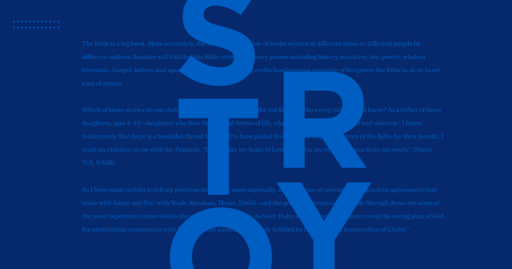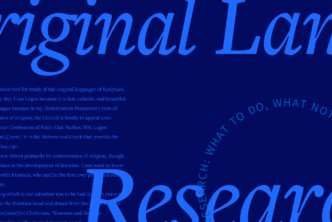The Bible is a big book. More accurately, the Bible is a collection of books written at different times to different people by different authors. Readers will find that the Bible contains literary genres including history, narrative, law, poetry, wisdom literature, Gospels, letters, and apocalypse. All, however, hang on the fundamental narrative of Scripture: the Bible is, at its heart, a set of stories.
Which of these stories do our children need to hear? What are the top Bible stories every child should know?
I would like to suggest that we take a cue from a comment made by the apostle Paul. N. T. Wright and Michael Bird say,
The purpose of scripture, Paul says in Romans 15:4, is so that “we might have hope.” He was speaking, of course, of Israel’s scriptures, but with hindsight, the same applies to the early Christian writings.1
As a father of three daughters, ages 4–13—daughters who face the ups and downs of life, who are full of disappointment and concern—I know instinctively that hope is a beautiful thread that need to have pulled from (and through) each story of the Bible for their benefit. I want my children to say with the psalmist, “For You are my hope; O Lord God, You are my confidence from my youth” (Psa 71:5 NASB).
So I have made certain to tell my precious daughters, most especially, all the stories of covenant. The gracious agreements God made with Adam and Eve, with Noah, Abraham, Moses, David—and the gracious promises God made through Jesus are some of the most important stories within the story that is Scripture. As Scott Hahn says, “Divine covenants reveal the saving plan of God for establishing communion with Israel and the nations, ultimately fulfilled by the death and resurrection of Christ.”2 Each covenant pushes divine hope into the story of the world. Each covenant shows us that God is a God of hope, and he is trustworthy. Here are the six stories I think everyone should know:
- Adam and Eve
- Noah and the ark
- Abraham and a sign
- Moses and the Ten Commandments
- David and a kingdom
- Jesus makes a new covenant
1. Adam and Eve
After God makes all creation, the people in that new creation are given a choice: God tells Adam and Eve they may eat from any tree in the garden except the tree in the middle of the garden, because if they eat, they will die (Genesis 3:2–3). This is sometimes referred to as the “Adamic covenant.” God’s creation was meant to be a place of order in which God would lovingly reign and his people would lovingly serve him in his presence by working and keeping the garden.
However, a serpent tempts Adam and Eve by twisting God’s Word. He deceives God’s image-bearers, they eat the fruit from the tree, and their eyes are opened to their nakedness. They see themselves in a different light than before they ate, and because they are embarrassed, they decide to make clothes for themselves out of fig leaves. They undermine their own reasons for hope through their horrific sin.
When God made everything, he said that it was good. Creation had order and purpose and made sense. Everything was in its proper place, but through Adam and Eve’s sin, chaos was introduced into God’s perfect order. All creation was affected. So this is a deeper story than one about merely two disobedient people. God’s perfect world has never been the same: sin had found its way into God’s good creation.
All might, then, have seemed hopeless for God’s new creation: God’s good work is ruined made. However, at just the right moment, we find God stepping in to provide hope through a covenant. He gives Adam and Eve a promise of redemption, a prophecy that one day the serpent’s head will be stomped on (Gen 3:15). Early on in the story of the Bible, we see God making promises that everything will one day be made right.
This is a story all kids need to know.
2. Noah and the ark
By the time we get to Noah, just a few chapters later, the sin, chaos, and disorder brought in by Adam and Eve are having their full effect.
Then the Lord saw that the wickedness of man was great on the earth, and that every intent of the thoughts of his heart was only evil continually. —Genesis 6:5 NASB
God decides things are so bad that he will send a flood to destroy all living things. The disorder we find in Adam and Eve’s story is amplified in the broken hearts of people in Noah’s day. Genesis 6:11 says the “earth was filled with violence.” At first glance, it seems death has the final say in God’s good creation. Violence is winning. We’re left wondering what God will do.
But, again, God comes to the rescue bringing hope through a covenant. He says to Noah,
I will establish My covenant with you; and you shall enter the ark—you and your sons and your wife, and your sons’ wives with you. —Genesis 6:18 NASB
As the drama of Noah unfolds, his family and representatives of the animal kingdom serve their time on the ark while the rest of creation is destroyed. But God has raised the terrifying possibility that human sin may negate his covenant: What’s to stop him from destroying all humanity if they come again the place of depravity described in Genesis 6?
Again we get a hope through a covenant:
I establish My covenant with you; and all flesh shall never again be cut off by the water of the flood, neither shall there again be a flood to destroy the earth. … This is the sign of the covenant which I am making between Me and you and every living creature that is with you, for all successive generations; I set My bow in the cloud, and it shall be for a sign of a covenant between Me and the earth. —Genesis 9:11–13 NASB
When God establishes his covenant with Noah, he shows his purpose for creation; he shows that he has the final say! Creation won’t ever be flooded again to destroy all flesh, and a rainbow is a reminder of this covenant. Covenants with God mean restoration for his creation. Disorder and violence are brought into the world by sin, but God’s command to “be fruitful and multiply” is part of his directive, put in motion to create a people who will worship him forever!
This is a story all kids need to know.

3. Abraham and a sign
The third covenant in Scripture is God’s covenant with Abraham, his promise to bless every family of the earth through Abraham’s seed (Gen 12:2–3; 22:17–18).
I will establish My covenant between Me and you and your descendants after you throughout their generations for an everlasting covenant, to be God to you and to your descendants after you. —Genesis 17:7 NASB
If the covenant with Noah acts like a prelude to the promise, the covenant with Abraham swells with imagery of how God will bring order into creation through supernatural renewal. Abraham and Sarah, whose aging bodies were “as good as dead” (Heb 11:12), would form the spark that brings the nation of Israel into being. God would bring miraculous life through them. While the sign of the covenant with Noah was a rainbow, the sign of this covenant was circumcision.
How does an old couple have a child? How will a nation come through this one child? How will that nation bless the whole world? Why would God tell Abraham to sacrifice that child (Gen 22:1–18)? For all of these impossible situations we’re given the answer in Genesis 22:14: “Abraham called the name of that place The Lord Will Provide, as it is said to this day, ‘In the mount of the Lord it will be provided.’” God’s covenant with Abraham reminds us that God provides; it’s a precursor to the ultimate provision from God, the provision of a Son to die on the cross because he loved the world.
This is a story all kids need to know.
4. Moses and the Ten Commandments
The story of Moses is one of my favorites in Scripture. It tells how God used Moses to free the Israelites from slavery in Egypt, how those same Israelites wandered in the desert for a long time, and how God led them into the land he promised to Abraham. This story is full of intrigue—mixed with hope, because God has made another covenant, this time with the nation of Israel. This covenant lives in continuity with the promise made to Abraham for blessing and land, except this time, God shows his expectation for his people to live distinctly by giving them the law, summarized in the Ten Commandments. The law was never meant to save; it was a shadow of better things to come. It gave a distinct culture to the Israelites. They were meant to live differently so that the world would be blessed.
However, time and time again, we find the Israelites complaining or sinning! Despite God freeing them from slavery, giving them provision in the wilderness for forty years, and leading them into the promised land, God called them “a stiff-necked people” (Exod 32:9). They were more interested in their selfish desires than being a representative of the covenant.
But God brings hope. And he would continue to have the final say over the renewal of creation. Moses said, “Moreover the Lord your God will circumcise your heart and the heart of your descendants, to love the Lord your God with all your heart and with all your soul, so that you may live” (Deut 30:6 NASB). As children move through these stories, they should be reminded how much God is concerned with the heart. The law can’t change the heart—it was never designed to—but it does show our need for a new heart that only God can give through faith in Jesus.
This is a story all kids need to know.
5. David and a kingdom
As God restores creation through a people with a distinct culture who will bless the whole world, he establishes an eternal kingdom through a covenant with David. “Truly is not my house so with God? For he has made an everlasting covenant with me, ordered in all things, and secured; For all my salvation and all my desire, Will he not indeed make it grow?” (2 Sam 23:5 NASB) The covenant with David gets more specific than God’s previous covenants, but they build on one another. This covenant gets specific in that the story of renewal comes into focus: God wants more than just a people with a distinct culture. He will renew creation through an eternal kingdom with a king.
Again, readers are left with questions. If God sets up a kingdom with David as king, what happens when David dies? Reading through the sordid history of the kings of Israel, we discover that the earthly kings can’t keep the covenant God made with David. The people of God need a king, but all the kings die.
What a wonderful day it was when Jesus, the son of David, came and began to preach, “Repent, for the kingdom of heaven is at hand” (Matt 4:17). As we come to the end of the list of Old Testament covenants, it is easy to see how each one points to God’s plan of redemption of humanity and the renewal of creation. But we can see how this becomes possible only when Jesus arrives on the scene of the story of the Bible. He brings hope. He’ll stomp on the serpent’s head. He’ll gather people from every tribe, tongue and language to be worshippers of God. He’ll ascend after his resurrection so the Holy Spirit can make his home in our hearts and give us circumcised hearts that love God! He’ll be the eternal king, risen from the dead, who reigns forever and ever! There is no one quite like Jesus, and all the covenants point to him.
This is a story all kids need to know.
6. Jesus makes a new covenant
Only by knowing all of the other hope-giving—but ultimately incomplete—covenants can a child understand the new covenant. When Jesus said, “This cup which is poured out for you is the new covenant in My blood” (Luke 22:20 NASB), that word “new” carries meaning precisely because of the old covenants that went before it.
The Lexham Survey of Theology says,
The new covenant, made by God with his people, was ratified at the cross of Christ, secures the gift of the Spirit, transforms hearts, and brings to completion the entire divine plan of redemption.”3
All the covenants God made until this point now demonstrate themselves to be a foretaste of what’s accomplished by Jesus, the mediator of the new covenant. And the best part is that God invites us into this covenant. Ever since Adam and Eve’s story, we’ve been wondering who would win: death or God. Each covenant is a moment when God promises not to let death have the final say over creation. However, the chaos and disorder that entered the world through Adam and Eve’s sin make us doubt and despair. People still die.
When Jesus came, he brought a new and living hope: he overcame death by his death and then rose from the dead! On Resurrection Sunday, his heart started beating, his lungs began breathing, and he became the firstborn from among the dead (Col 1:18). There are more benefits to the new covenant, but one of my favorites is that everyone who is part of the new covenant will be raised from the dead, just like Jesus! Followers of Jesus experience the covenant forever and ever.
For he must reign until he has put all his enemies under his feet. The last enemy that will be abolished is death. For he has put all things in subjection under his feet. But when he says, “All things are put in subjection,” it is evident that he is excepted who put all things in subjection to him. When all things are subjected to him, then the Son himself also will be subjected to the One who subjected all things to him, so that God may be all in all.” —1 Corinthians 15:25–28 NASB
There are stories all kids—and adults—need to know.

- N. T. Wright and Michael F. Bird, The New Testament in Its World: An Introduction to the History, Literature, and Theology of the First Christians (London; Grand Rapids, MI: Zondervan Academic; SPCK, 2019), 888.
- Scott Hahn, “Covenant,” in The Lexham Bible Dictionary, ed. John D. Barry et al. (Bellingham, WA: Lexham Press, 2016).
- Brian Collins, “The New Covenant,” in Lexham Survey of Theology, ed. Mark Ward et al. (Bellingham, WA: Lexham Press, 2018).





